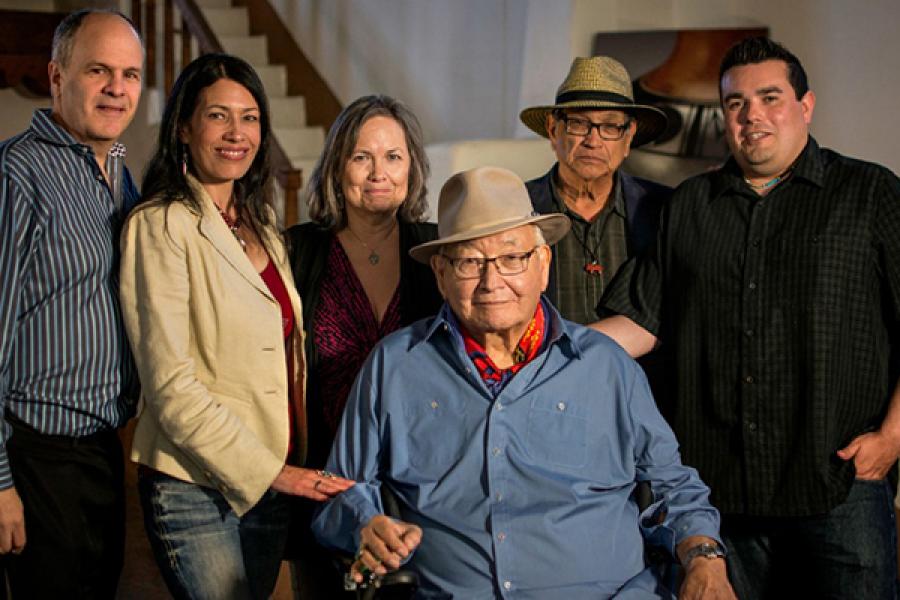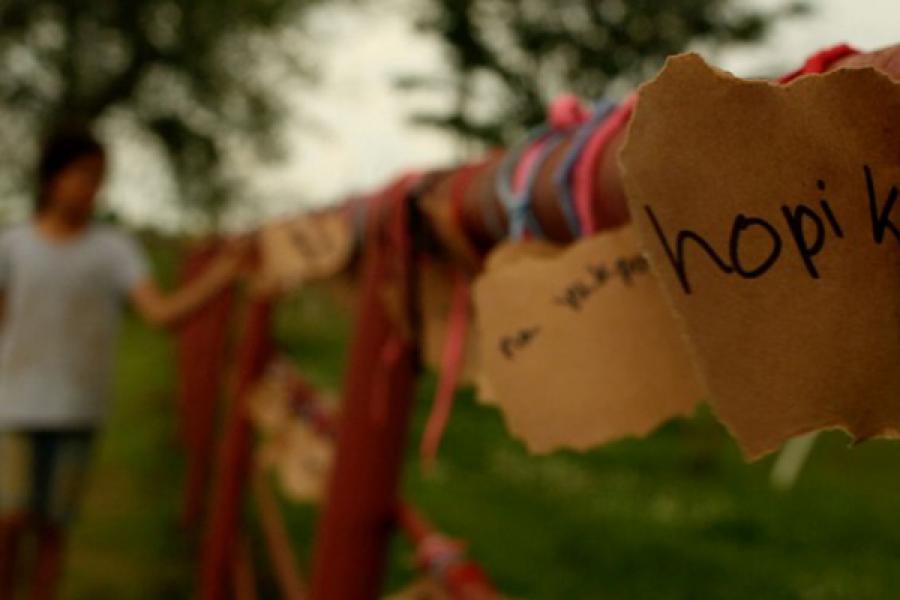Jeff Palmer grew up taking long walks with his father in the Wichita Mountains of southwestern Oklahoma. Palmer’s father, a linguist and a native Kiowa speaker, told him ancient Kiowa stories about the granite-capped peaks and rolling hills around them.
An enormous butte known as Devils Tower was formed, his father said, when a boy turned into a bear and chased his seven sisters onto a tree stump. The bear clawed at the stump as it rose high in the sky. The sisters were swept upward and became the stars of the Pleiades. The bear’s claw marks can still be seen on the striated butte, according to the story. The Kiowa name for the butte, Tsoai, means “Rock Tree.”
“Out there, you always feel connected to the ancient world, and the stories that your grandparents or your father or your mother may tell you,” says Palmer, a member of the Kiowa tribe. “Indigenous storytelling is interesting because the ancient has to be present. There’s a comfortable relationship between past and present. It’s less linear than other storytelling modes can be.”
Now Palmer uses indigenous storytelling techniques to reveal Native Americans’ untold stories while pushing the limits of documentary film. An assistant professor of performing and media arts in the College of Arts and Sciences (A&S), Palmer has been nominated for an Emmy Award and his films have appeared in major festivals, from the Sundance Film Festival to the Berlin Independent Film Festival.
“What I try to do is an examination of all of Native Americans’ amazing contributions to this country in the 20th and 21st centuries,” Palmer says. “That examination is really about bringing untold stories of Native people that have really never really been part of the historical examination of America.”
His film “Sounds of Life” explores the way music helped revive a teenage girl from the Omaha tribe in Minneapolis; not many people realize Native people have a long history in the urban experience, Palmer says. “Grave Misgivings” follows an Apache artist as she contemplates the life and legacy of Geronimo, the longest-held prisoner of war in U.S. history.
“Honor Beats” observes the vibrant Native culture of the Midwest, and the non-Indian audiences’ appetite for recording Indian performers. And “Disqualified Warriors” follows the loss and redemption experienced by Palmer’s father, Gus, at being unable to participate in the warrior tradition.
“What Jeff brings to the discussion is a finely crafted notion of Indigenous storytelling,” says Jolene Rickard, associate professor of the history of art and visual studies in A&S, “that actually is a combination of both his formal education and also a demonstration of what he has inherited in his family – that much older inheritance of learning how to carry knowledge from one generation to the next.”
A girl and her garden
Palmer took an unconventional route to filmmaking. After studying cultural anthropology as an undergrad and earning a master’s degree in Native American studies at the University of Oklahoma, he went through “a lot of trial and tribulation” in his 20s. He started law school. He started a Ph.D. program in history.
All along, what he really wanted was to study film.
In his mid-30s, he enrolled in the film program at the University of Iowa. He didn’t realize then that Native material would figure so heavily in his work. “I was into (Quentin) Tarantino and (Martin) Scorsese and (Stanley) Kubrick,” he says. “That also has to do with the fact that there weren’t a ton of Native filmmakers in the industry.”
Nonetheless, the landscapes of his childhood featured prominently in his thesis film, “Origins.”
“It was a letter to my grandfather, and what his answers would be to some of these pressing questions I had about how things were changing today,” he says. “I wanted to tell him what Kiowa life was today, and he was telling me what it was a long time ago.”
Palmer’s father spoke, in Kiowa, as his grandfather; simple animation conveyed the ancient ways of life and the ways they’d changed.
“Origins” was one of half a dozen experimental films he had made by then. Not one had made it into the festival circuit, the gateway to success for most filmmakers.
“Most people, when they get into film festivals, they start out with local film festivals or regional. I couldn’t even get into those,” he says. “And I thought, maybe I’m not a good filmmaker. Maybe my films are too personal. I had really been banging my head for years, trying to understand what my vision was, what my aesthetic is. I was developing.”
With his next film, he decided to do something different.
“I said, I’m not going to spend any money on this. I’m going to come up with a story that relates to a lot of people,” Palmer said. “I’m going to do it in less than 10 minutes. And I’m going to use conventions – and not feel bad that I’m not being revolutionary.”
When he saw the Sundance Film Festival was holding a special contest for short films about poverty, he started looking for ideas.
He shot “Isabelle’s Garden” over a weekend, with a crew of inexperienced film students. It tells the magical story of a Choctaw girl who grows vegetables for her neighbors, who help her in return. She tells her story in voiceover, in English and Choctaw. Some elements are based in reality – Isabelle Cox did have a garden in southeastern Oklahoma, where many people live with food insecurity – while other elements are fictional.
“Isabelle’s Garden” beat out 14,000 entries to make it into the Sundance Film Festival in 2014. It went on to play at major film festivals around the world.
“I always tell my students, ‘An eight-minute film changed my life,’” Palmer says, “because it did.”
“Words from a Bear”
That notoriety won him a commission from the Public Broadcasting Service’s “American Masters” series to make his most recent film, “N. Scott Momaday: Words from a Bear.” The feature-length biopic examines the life and mind of one of Native America’s most celebrated writers of poetry and prose. Momaday, who grew up near Palmer, influenced a generation of artists, scholars and activists. His novel“House Made of Dawn” won the Pulitzer Prize for fiction in 1969; he is thus far the only Native American to win that honor.
Palmer uses documentary conventions to chronicle Momaday’s accomplishments from the 1950s to the present day, with commentary from artists including Robert Redford and U.S. Poet Laureate Joy Harjo, who’s Native American. But Palmer also uses Momaday’s poetry and voice as an articulation of Kiowa history, representing Momaday’s words with experimental techniques, from reenactments and animation to historical footage and Kiowa landscapes.
The film premiered at the Sundance Film Festival and was nominated for an Emmy as part of the “American Masters” series. It also broke new ground in indigenous filmmaking, says Bird Runningwater, director of the Sundance Institute’s indigenous film program.
“I’m always looking at artists who break out of traditional canons of filmmaking,” Runningwater says, “and he had really honed in on what I would call a Kiowa aesthetic in filmmaking with that film, which is something I’d never seen.”
Says Palmer: “It’s also a story about America. It’s a story about who we are as Americans and our history and relationship.”
Those themes may run through his next project – a documentary about the Cayuga people of upstate New York. Palmer is working with Rickard and faculty members in Cornell’s American Indian and Indigenous Studies Program to examine issues of sovereignty, the preservation of language and traditions, and the Cayuga people’s relationship to the region from which they were extricated.
Says Palmer: “Everybody’s experience and everybody’s story is important.”
Read the story in the Cornell Chronicle.






